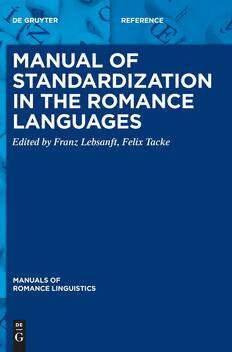
Manual of Standardization in the Romance Languages PDF
Preview Manual of Standardization in the Romance Languages
ManualofStandardizationintheRomanceLanguages MRL24 Manuals of Romance Linguistics Manuels de linguistique romane Manuali di linguistica romanza Manuales de lingüística románica Edited by Günter Holtus and Fernando Sánchez-Miret Volume 24 Manual of Standardization in the Romance Languages Edited by Franz Lebsanft and Felix Tacke ISBN978-3-11-045573-1 e-ISBN(PDF)978-3-11-045808-4 e-ISBN(EPUB)978-3-11-045606-6 LibraryofCongressControlNumber:2019946307 BibliographicinformationpublishedbytheDeutscheNationalbibliothek TheDeutscheNationalbibliothekliststhispublicationintheDeutscheNationalbibliografie; detailedbibliographicdataareavailableintheInternetathttp://dnb.dnb.de. ©2020WalterdeGruyterGmbH,Berlin/Boston Coverimage:©Marco2811/fotolia Typesetting:MetaSystemsPublishing&PrintservicesGmbH,Wustermark Printingandbinding:CPIbooksGmbH,Leck www.degruyter.com Manuals of Romance Linguistics The new international handbook series Manuals of Romance Linguistics (MRL) will offeranextensive,systematicandstate-of-the-artoverviewoflinguisticresearchin theentirefieldofpresent-dayRomanceStudies. MRLaimstoupdateandexpandthecontentsofthetwomajorreferenceworks availabletodate:LexikonderRomanistischenLinguistik(LRL)(1988–2005,vol.1–8) and Romanische Sprachgeschichte (RSG) (2003–2008, vol. 1–3). It will also seek to integrate new research trends as well as topics that have not yet been explored systematically. Given that a complete revision of LRL and RSG would not be feasible, at least not in a sensible timeframe, the MRL editors have opted for a modular approach thatismuchmoreflexible: The series will include approximately 60 volumes (each comprised of approx. 400–600 pages and 15–30 chapters). Each volume will focus on the most central aspects of its topic in a clear and structured manner. As a series, the volumes will covertheentirefieldofpresent-dayRomanceLinguistics,buttheycanalsobeused individually.GiventhattheworkonindividualMRLvolumeswillbenowherenear astime-consuming asthat onamajor referencework inthe styleofLRL, itwill be mucheasiertotakeintoaccounteventhemostrecenttrendsanddevelopmentsin linguisticresearch. MRL’s languages of publication are French, Spanish, Italian, English and, in exceptionalcases,Portuguese.Eachvolumewillconsistentlybewritteninonlyone oftheselanguages.Ineachcase,thechoiceoflanguagewilldependonthespecific topic.Englishwillbeusedfortopicsthatareofmoregeneralrelevancebeyondthe fieldofRomanceStudies(forexampleManualofLanguageAcquisitionorManualof RomanceLanguagesintheMedia). The focus of each volume will be either (1) on one specific language or (2) on one specific research field. Concerning volumes of the first type, each of the Ro- mancelanguages–includingRomance-basedcreoles–willbediscussedinasepa- rate volume. A particularly strong focus will be placed on the smaller languages (linguaeminores)thatotherreferenceworkshavenottreatedextensively.MRLwill comprisevolumesonFriulian,Corsican,Galician,amongothers,aswellasaMan- ual of Judaeo-Romance Linguistics and Philology. Volumes of the second type will be devoted to the systematic presentation of all traditional and new fields of Ro- mance Linguistics, with the research methods of Romance Linguistics being dis- cussed in a separate volume. Dynamic new research fields and trends will yet again be of particular interest, because although they have become increasingly importantinbothresearchandteaching,olderreferenceworkshavenotdealtwith thematallortoucheduponthemonlytangentially.MRLwillfeaturevolumesdedi- catedtoresearchfieldssuchasGrammaticalInterfaces,YouthLanguageResearch, Urban Varieties, Computational Linguistics, Neurolinguistics, Sign Languages or https://doi.org/10.1515/9783110458084-202 vi ManualsofRomanceLinguistics ForensicLinguistics.Eachvolumewillofferastructuredandinformative,easy-to- readoverviewofthehistoryofresearchaswellasofrecentresearchtrends. We are delighted that internationally-renowned colleagues from a variety of Romance-speaking countries and beyond have agreed to collaborate on this series and take on the editorship of individual MRL volumes. Thanks to the expertise of the volume editors responsible for the concept and structure of their volumes, as well asfor the selection ofsuitable authors, MRL willnot only summarizethe cur- rent state of knowledge in Romance Linguistics, but will also present much new informationandrecentresearchresults. As a whole, the MRL series will present a panorama of the discipline that is both extensive and up-to-date, providing interesting and relevant information and usefulorientationforeveryreader,withdetailedcoverageofspecifictopicsaswell asgeneraloverviewsofpresent-dayRomanceLinguistics.Webelievethattheseries will offer a fresh, innovative approach, suited to adequately map the constant ad- vancementofourdiscipline. August2019 GünterHoltus(Lohra/Göttingen) FernandoSánchez-Miret(Salamanca) Preface The standardization of Romance languages is a well-established domain in Ro- mance studies. As shown in our detailed introduction (“Romance standardology: roots and traditions”), there is a considerable amount of research on this classical issue, and all the contributors to this manual draw heavily on it. However, this volumestrivestodomorethanjustprovideanessentialupdateofpreviousresearch findings. The first part of the book, dedicated to the theories of linguistic norm, presents,ofcourse,overviewsontraditionalandprovenmethodologies,whichhave constantly enhanced our understanding of standardization. Nonetheless, it also ventures to include more recent approaches to theconstruction of regulated forms of language that are not easily found in former manuals. In the same manner, the secondpartonlanguage-specificinstrumentsandreferencetoolscombinesarticles treating the traditional realm of language codification and modernization (i.e., or- thographies, normative dictionaries and grammars). This engaging sectionencom- passeselaborateanalysisofthehithertoneglectedissueofnormativepronunciation (orthoepy) as well as the ever more dynamic field of usage guides (the so-called dictionariesoflanguagedifficulties). From the standpoint of standardization, it is justifiable to distinguish between “major” and “minor” Romance languages. The chapters on Romanian, Italian, French, Catalan, Spanish and Portuguese always follow the same, full-fledged scheme (four articles each); a more concise chapter is dedicated to “minor” Italo-, Gallo-andIbero-RomancelanguagesnottomentionRomance-basedCreoles.Even thougheachlanguageistreatedseparately,theintroductoryessayadditionallycon- tainsasectionintendedtoprovidethereaderwithacomparativeapproach. Itgoeswithoutsayingthatinordertobeusefulandeasilyaccessible,amanual needs a coherent structure and an analogous, corresponding treatment of the ob- jects. However, if the reader detects excessive or disturbing heterogeneity in the presentationof(someof)thedata,weaseditorshavefailedtoconvincethecontri- butorsofthewell-foundednessofourapproach.Weassume,ofcourse,responsibili- tyforanyshortcomingsinthisrespect. ManyesteemedcolleagueshavecontributedtomakingtheideaofaManualof Standardization in the Romance Languages come true. First of all, we’d like to thank our General Series Editors Günter Holtus and Fernando Sánchez-Miret for their patience and support; of course, a lot of gratitude goes out to the many con- tributors of this volume – those who have fulfilled the promise of a substantial article and those who have generously helped us out in the case of a few missing articlesbyassumingthattaskonshortnotice.Furthermore,wealsowishtothank StevenDworkinforhisadviceintheearlystagesofthisvolume.Wewouldalsolike toexpressourappreciativenesstoBrandonDavenport,whohastirelesslyimproved thestyleofmanymanuscripts,aswellastoJudithStrunck,TheaGöhringandJudith Harzheim,whorendered theirservicesoflaboriouslyreading andcopy-editingthe https://doi.org/10.1515/9783110458084-203 viii Preface wholevolume.Lastbutnotleast,manythankstotheDeGruytereditorialteamfor their unconditional assistance we received during the long editing process: Ulrike Krauß, Christine Henschel, Gabrielle Cornefert, Anna Hofsäß and Monika Pfleghar. Bonn,June2019 FranzLebsanftandFelixTacke Table of Contents Introduction FranzLebsanftandFelixTacke 0 RomanceStandardology:RootsandTraditions 3 Theories of Linguistic Norm LudwigFesenmeier 1 LinguisticNorminClassicalGrammarandRhetoric 63 JörnAlbrecht 2 LinguisticNorminthePragueSchoolofLinguistics 107 JohannesKabatek 3 LinguisticNormintheLinguisticTheoryofEugenioCoseriu 127 CarstenSinner 4 LinguisticNorminSociolinguistics 145 AngelaSchrott 5 LinguisticNorminLinguisticPragmatics 165 FelixTacke 6 LinguisticNorminCognitiveLinguistics 183 FranzLebsanft 7 LinguisticNorminDiscourseLinguistics 209 Instruments and Reference Tools for Language Codification and Modernization 8 Romanian 231 CameliaStan 8.1 OrthographyandOrthoepy 231 x TableofContents RodicaZafiu 8.2 NormativeGrammars 245 RodicaZafiu 8.3 NormativeDictionaries 261 IsabelaNedelcu 8.4 DictionariesofLanguageDifficulties 281 9 Italian 297 GeraldBernhard 9.1 OrthographyandOrthoepy 297 ElisaDeRoberto 9.2 NormativeGrammars 317 LucaLorenzetti 9.3 NormativeDictionaries 341 LucaLorenzetti 9.4 DictionariesofLanguageDifficulties 373 10 French 399 BernhardPöll 10.1 OrthographyandOrthoepy 399 SybilleGroße 10.2 NormativeGrammars 417 LucaMelchior 10.3 NormativeDictionaries 441 JohannaWolf 10.4 DictionariesofLanguageDifficulties 461 11 Catalan 481 DavidPaloma 11.1 OrthographyandOrthoepy 481
